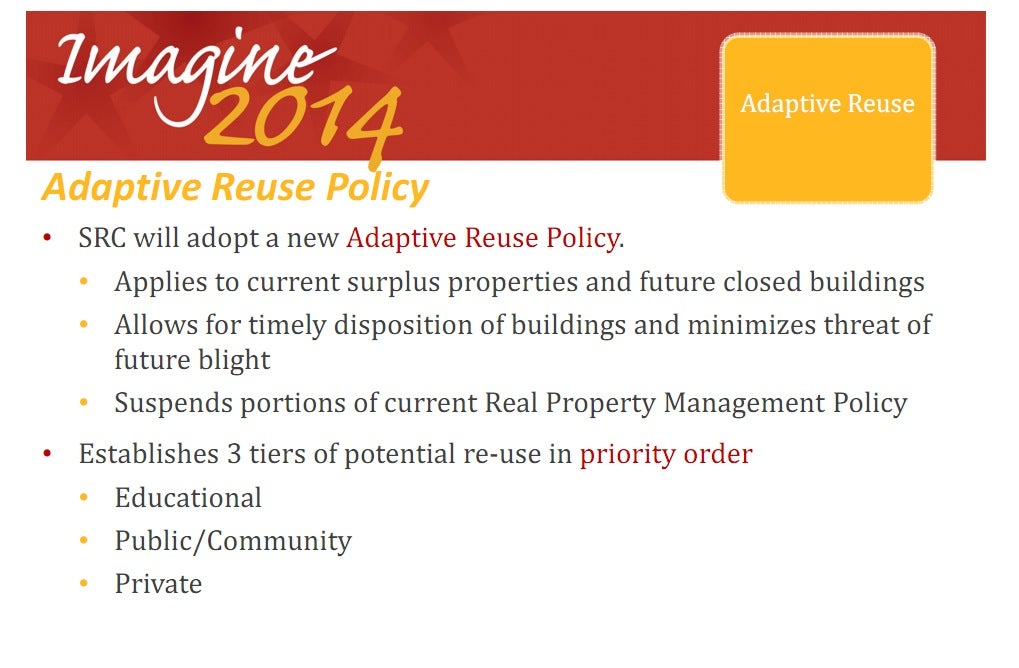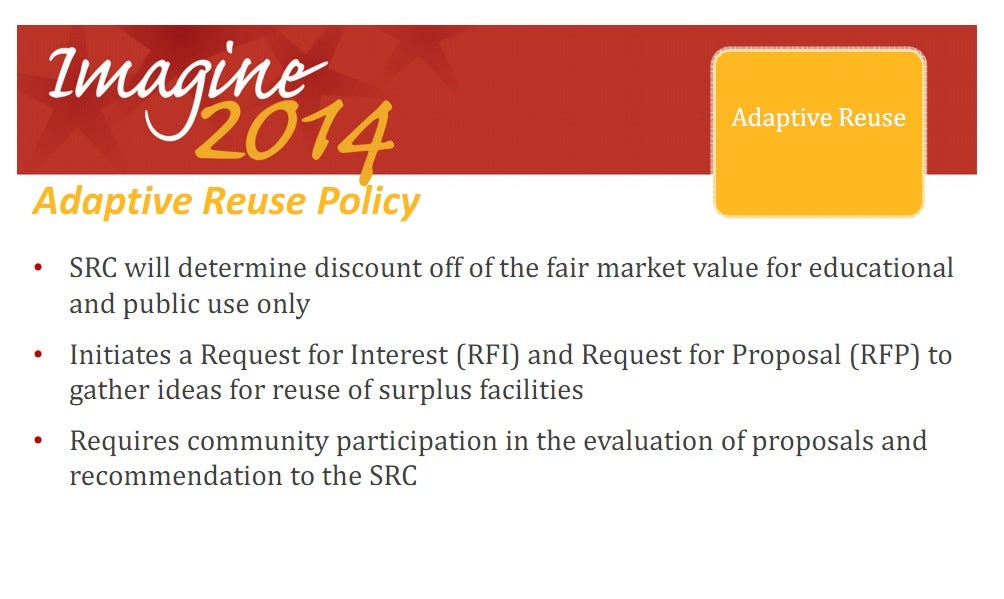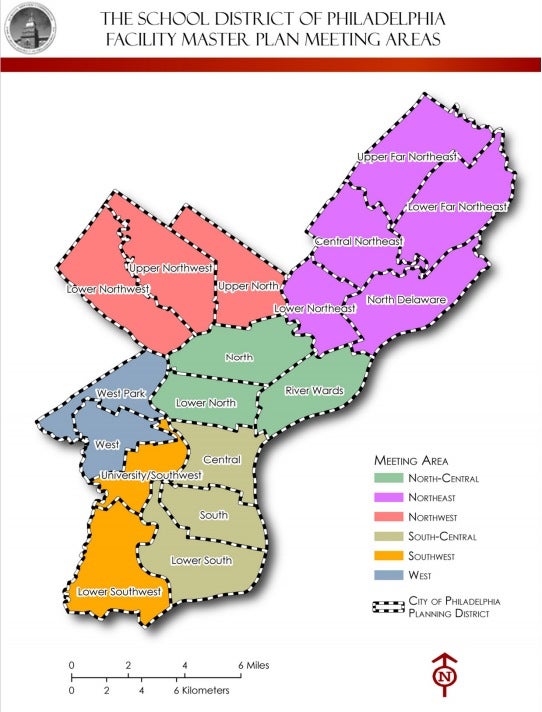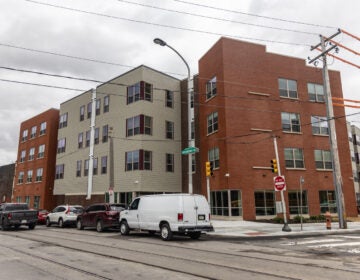Q&A: School District officials on closings and “adaptive reuse”
On April 7, the School District of Philadelphia unveiled a new draft of its Facilities Master Plan, calling for up to 50 buildings to be closed by 2014. PlanPhilly has partnered with the Public School Notebook to cover the impact those closings will have not just on students and families, but on the communities the schools serve and the built environment of Philadelphia.
Last week, PlanPhilly wrote about the District’s newly proposed “adaptive reuse” policy, which is intended to guide the disposition of shuttered school buildings. The district is now hosting a series of community meetings to get feedback on their school closings plan, including the draft adaptive reuse police. Last week, the Notebook sat down for an extensive 90-minute interview with two figures who were instrumental in writing that plan, district Deputy for Strategic Initiatives Danielle Floyd and consultant Tracy Richter of DeJong-Richter.
They addressed a key question: How will the district decide what to do with the schools it closes?
Check the Notebook later this week for more Q&A’s on the district’s plans.
Potential uses: educational, public, and private
In the draft adaptive reuse policy, the District lays out three types, or “tiers”, of potential reuses for unused school buildings: Educational reuses, given the highest priority; Public reuses; and Private reuses, given the lowest priority.
As it currently stands, the proposal calls for the District to decide internally whether a building should be, for example, converted into a charter school or into condominiums. After that decision has been made, the public would then be involved in evaluating specific proposals from candidates to buy the building.
Notebook: Looking at the proposed policy, it seemed that the public really isn’t involved until the tier is designated.
FLOYD: That’s true. The way that it is currently structured, yes.
Notebook: Why is that?
FLOYD: I think that when we worked on putting this policy together, where we thought the public could have the greatest input was in evaluating proposals. Evaluating the types of uses that would come in and being able to make a recommendation to the [School Reform Commission, or SRC] about in their particular community, what would be beneficial.
Notebook: So allow me to play devil’s advocate here…If a school building is proposed to be converted into housing, inevitably there are going to be residents in the surrounding community who are going to be upset about that. But it seems that the District is retaining the sole authority to decide which communities get housing and which get public uses…Why would the public not be involved in deciding what type of reuse is created for their school?
TRACY RICHTER: I might be able to talk to that. There are some restrictions around public facilities that are paid for with public dollars that come in banking laws, and bonding borrowing dollars law, and things like that, that the District gets specifics on from bond council. To dispose of a building isn’t as simple as giving it an appraised value and selling it, in any public entity. The city government can’t go out and sell city hall because taxpayers paid for that building, for instance. So there’s restrictions around how you can dispose of buildings and what uses they can go to. Although the opportunities for all three are there, it could be restricted to what bond paid for it or what kind of dollars paid for it.
Notebook: So you’re saying that the types of reuses are going to be governed by the legalities and financing?
RICHTER: As just one component. It’s just one component of a lot of different things. But that is one influence on it, absolutely.
Notebook: But you’re saying the public is not equipped to sort through that as one component?
RICHTER: That’s not what I’m saying at all. I’m saying that part of, it could be that because of one influence like that, the only thing you can do is sell it to another educational. So in that case, not even the school district has a say, let alone the community. That’s what I’m saying.
Notebook: But for the other cases, why not involve in the public? … Because as I read the policy, it seemed that in the cases where multiple potential types of reuses are available, that the public is not involved in that decision.
FLOYD: The way that it is currently written, that’s correct. Which again is why it’s draft and we’re putting this out there for people to comment on and give us feedback. That may be something that we get back that says there’s a recommendation that the public, a recommendation for a change to the policy is to put that in there…
I think this is a unique thing for Philadelphia to be doing. The current policy that exists right now, the public…[has] no role at all. So I think what you’re seeing from us is one, a recognition that buildings play a significant role in communities, two, in the conversations that we’ve had as part of this process and even prior to that, people have said we want to be able to be engaged in making decisions about what happens here.
Finding a developer
The draft Adaptive Reuse Policy also outlines the process by which developers, charter school operators, nonprofits, and others can acquire District properties that are no longer in use. The proposal calls for groups to first respond to a general Request for Interest that is not specific to a particular building, then be invited to submit a proposal if a relevant property comes up for sale.
Notebook: For those who might be interested in acquiring a building for reuse, talk to me a little bit about just how that process is supposed to work
FLOYD: Well I think that part of the reason is that what we’ve been trying to do is separate procedure from policy. There are things that you would do, that as a district entity staff would do, but as an SRC policy you don’t necessarily outline all of your procedures in that. I think part of it is in previous policies, especially if you look at the current real estate policy, it goes through a lot of procedural things that when you look at it, that’s not the role of what a policy is. The role of a policy is to be able to set a priority and give you a framework by which to operate. So how the RFI process and the RFP process would work would never be delineated within a policy … I think we’re going to be looking to other entities in the city who do this type of work, this is their skill set and expertise, to help us manage this process. I would say we’re still very much in the early stages of how we would put that together. The intent, however, what we plan to do is consult with agencies who have that skill set and expertise to help us think that through.
Notebook: It seems a little bit odd to ask a developer, for example, or even a charter operator to say, ‘Well, we’re interested in some property, but we’re not sure which, where, or for what use.’
FLOYD: Depending on who you are, you may have a particular interest in one part of the city. And so, this is the community that I serve, and so if something were to come up for sale as part of this process in this particular neighborhood, those are the only circumstanced under which I’m interested. Our thought…was to say, “What are the areas that you serve or the areas that you would be expressing an interest in doing work in, so that we know that…if a school is identified for closure…we already know in advance who are the people who have expressed an interest in this part of the city for whatever type of use …
Notebook: When are you expecting the procedures to be ready, and are they going to govern the disposition of the seven buildings that have been identified to get rid of now?
FLOYD: That’s the intent, yes. Right now, the SRC is planning to vote on the adaptive reuse policy on May 18. So we’re using the time between now and May 18 to get the RFI…and be able to go as soon as we possibly can after the adaptive reuse policy has been approved.
Notebook: Has there been a competitive bid process for the potential [real estate] brokers already?
FLOYD: Yes, there was. We may end up redoing that…we’ve looked at it a couple different ways. You could have multiple brokers managing lots of different buildings or you could go through one broker and have them manage your entire portfolio. If we go that route, we would need to do a new request for proposal. So I think that we’re just still having discussions internally.
Patrick Kerkstra contributed to this report.
WHYY is your source for fact-based, in-depth journalism and information. As a nonprofit organization, we rely on financial support from readers like you. Please give today.










